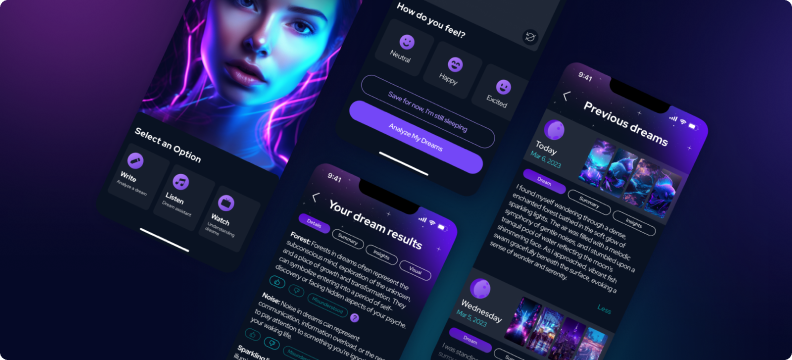Explore the Freud Interpretation of Dreams, revealing the profound insights it offers into our unconscious desires and emotions.

When it comes to the sphere of psychology, Sigmund Freud stands as a titan whose influence transcends time. His groundbreaking work on dream analysis, prominently featured in his seminal book - the Freud Interpretation of Dreams, has fundamentally altered our comprehension of unconscious desires.
Even today, his theories continue to shape the discourse in psychoanalysis. Read on to learn more about the key insights behind this dream theory.
Imagine viewing dreams not as random neural firings during sleep but as coded messages delivered straight from our subconscious. That's precisely the shift in perspective that Freud's Interpretation of Dreams brought about.
Freud argued that our dreams aren't merely fantastical tales spun by our sleeping minds. Instead, they're revealing narratives that uncover our deepest desires - desires that we often suppress during our waking hours due to societal or personal inhibitions.
Take, for example, a dream where you're flying. On the surface, it might seem like an exhilarating adventure. However, according to Freud, this dream could symbolize a deep-seated desire for freedom or escape from certain constraints in your life.
Freud proposed an intriguing concept: every dream carries two levels of content. The first level, known as the manifest content, is the storyline or images we remember upon waking. It's the plot of the dream that we can recall and narrate.
On the other hand, latent content is the symbolic meaning hidden beneath the surface of the manifest content. This hidden layer represents repressed desires seeking fulfillment. Going back to the flying dream example, the act of flying (manifest content) might symbolize a yearning for freedom (latent content).
At the heart of Freudian theory lies a compelling idea: our unconscious mind is a treasure trove of desires and memories that our conscious mind might find unsettling or unacceptable.
These suppressed emotions and thoughts can find an outlet in our dreams, providing us with invaluable psychological insights. By interpreting our dream's manifest and latent content, we can gain a greater understanding of what drives us, allowing us to make more informed decisions about our lives.
For example, if the manifest content of a dream involves an argument with a friend, the latent content could be related to our feeling of guilt or insecurity around that person. By recognizing our true feelings, we can address this issue in a more productive way and build healthier relationships.
Freud's Interpretation of Dreams, while a significant milestone in psychology, hasn't escaped criticism. Detractors argue that his theories are too subjective and lack concrete empirical evidence.
However, despite these criticisms, Freud's emphasis on the importance of dreams in understanding our unconscious mind has had an indelible impact on modern psychoanalysis. In fact, dream interpretation still stands as one of the core tools in navigating and understanding our innermost desires.
A good example of this is the concept of "active imagination" which involves actively engaging with our dream content in order to discover insights about our unconscious desires. In many ways, this process has its roots in Freud's Interpretation of Dreams.
In our quest to understand the subconscious mind and its mysteries, modern technology presents an exciting avenue. Enter SeventhSIGHT�a cutting-edge tool that uses patented Machine Learning Artificial Intelligence to analyze the meaning of your dreams.
SeventhSIGHT aims to bridge the gap between traditional dream interpretation methods and the digital age. It takes Freud's fundamental principles of dream analysis and supercharges them with the power of artificial intelligence. This unique fusion allows it to extract powerful insights from your dreams, helping you better understand your daily life and what your subconscious is trying to communicate.
Think of SeventhSIGHT as your personal dream interpreter, but one that operates on a much more sophisticated level. It doesn't merely decipher the manifest content of your dreams-the images and narratives that we consciously remember. Instead, it delves deeper, seeking to uncover the latent content-those symbolic, often hidden meanings that Freud believed represented our repressed desires.

By using SeventhSIGHT, you're not just getting a surface-level interpretation of your dreams. You're gaining a profound understanding of your unconscious desires, fears, and aspirations. It's like having a direct line to your subconscious, providing you with valuable insights that can guide you in your waking life.
So, whether you're a staunch believer in Freudian theory or simply curious about the untapped potential of your dreams, SeventhSIGHT offers a fascinating, technologically advanced approach to dream interpretation.
Sigmund Freud believed that dreams are vehicles for our repressed desires. In his view, the story or images from our dreams (manifest content) often mask the deeper, symbolic desires (latent content).
Absolutely! Even more than a century after its publication, Freud's insights into dream analysis continue to resonate within the field of psychology. The book provides unique perspectives on understanding our unconscious mind.
Freud penned The Interpretation of Dreams to introduce his revolutionary theory that dreams are not random but meaningful explorations of our unconscious desires. He saw dreams as a 'royal road' to unraveling the mysteries of the human psyche.
Critics of Freud's dream theory argue that it is overly subjective and lacks empirical evidence. Some also contend that not all dreams carry significant symbolic meaning or link to repressed desires.
The legitimacy of dream interpretation is a hotly debated topic. While some psychologists, like Freud, advocate that dreams carry significant meaning, others argue that dreams are simply the result of random brain activity during sleep. Ultimately, the value of dream interpretation may vary based on individual beliefs and experiences.
Dreams have fascinated cultures around the world for centuries, and Sigmund Freud's Interpretation of Dreams laid the foundation for modern dream analysis. While some of Freud's ideas have come under criticism, his emphasis on our unconscious mind has had an enduring influence on psychological research.
Today, technology is pushing dream interpretation to new heights. SeventhSIGHT is a cutting-edge tool that uses Artificial Intelligence to analyze the meaning of your dreams. By uncovering the symbolic, latent content of your dream, it can provide invaluable insights into our unconscious desires.
Whether you choose to pursue traditional dream interpretation or explore the potential of AI-driven tools like SeventhSIGHT, one thing remains true: There is still much to learn about our subconscious mind - and dreams can serve as the gateway to discovering these mysteries.